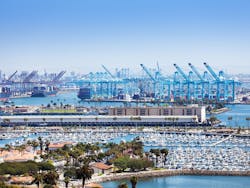California PUC Rejects Challenge by Long Beach to Microgrid Decision
The California Public Utilities Commission (CPUC) has rejected an argument by Long Beach that the commission failed to achieve the state’s goal of overcoming barriers to microgrid development in a January tariff decision.
Through its Board of Harbor Commissioners, Long Beach challenged three aspects of the decision, which grew out of a state law, SB 1339, designed to boost commercialization of microgrids.
The city argued the PUC failed to remove a major barrier to microgrid development, which has slowed efforts to develop a microgrid at the Port of Long Beach.
The PUC made a mistake by failing to address a Southern California Edison rule generally barring the resale of the utility’s electricity, according to Long Beach. The rule, called Rule 18, is a “major” barrier to microgrid development, according to the board, which oversees a 3,200-acre port handling about a fifth of the cargo moving through US ports.
In a situation where an energy storage facility partly charges from power supplied by a utility, the utility can prevent the microgrid owner from selling power from the storage device to another entity, according to the board.
PUC rejects Long Beach arguments
In a decision released April 16, the PUC said Long Beach was wrong in its assertion that the commission was required by California’s microgrid law to remove or reduce “all” potential barriers to microgrid commercialization.
The law directs the PUC to “reduce barriers,” not “remove barriers” or “reduce all barriers,” as the city alleged, according to the commission.
“[SB 1339] does not require the commission to reduce or eliminate all barriers to microgrid commercialization, including every potential barrier to each type of possible microgrid configuration,” the PUC said.
In describing how the PUC’s decision lined up with SB 1339’s goals, the commission noted it had ordered the state’s major investor-owned utilities to allow microgrids owned by public agencies, or a third-party that serves a facility operated by a public agency, to supply electricity to a critical facility operated by a municipal corporation on an adjacent premise to conduct emergency and critical operations during a grid outage.
Also, Long Beach argued the PUC used an outdated list of critical facilities in its decision. The list didn’t include maritime transportation, according to the harbor board.
The PUC dismissed the argument, saying the list was subject to future changes.
Finally, the PUC dismissed Long Beach’s concerns that the decision implied nonregulated entities, like cities, could come under PUC jurisdiction through the “over-the-fence” rule. The rule requires entities be deemed utilities if they sell electricity to more than two adjacent parcels or across the street.
The PUC agreed that municipal corporations, like Long Beach, never come under PUC jurisdiction, saying the issue was “settled law.” It also clarified that there were “limited exceptions” to the over-the-fence rule.
Track news about policy related to microgrid development. Subscribe to the free Microgrid Knowledge Newsletter.
